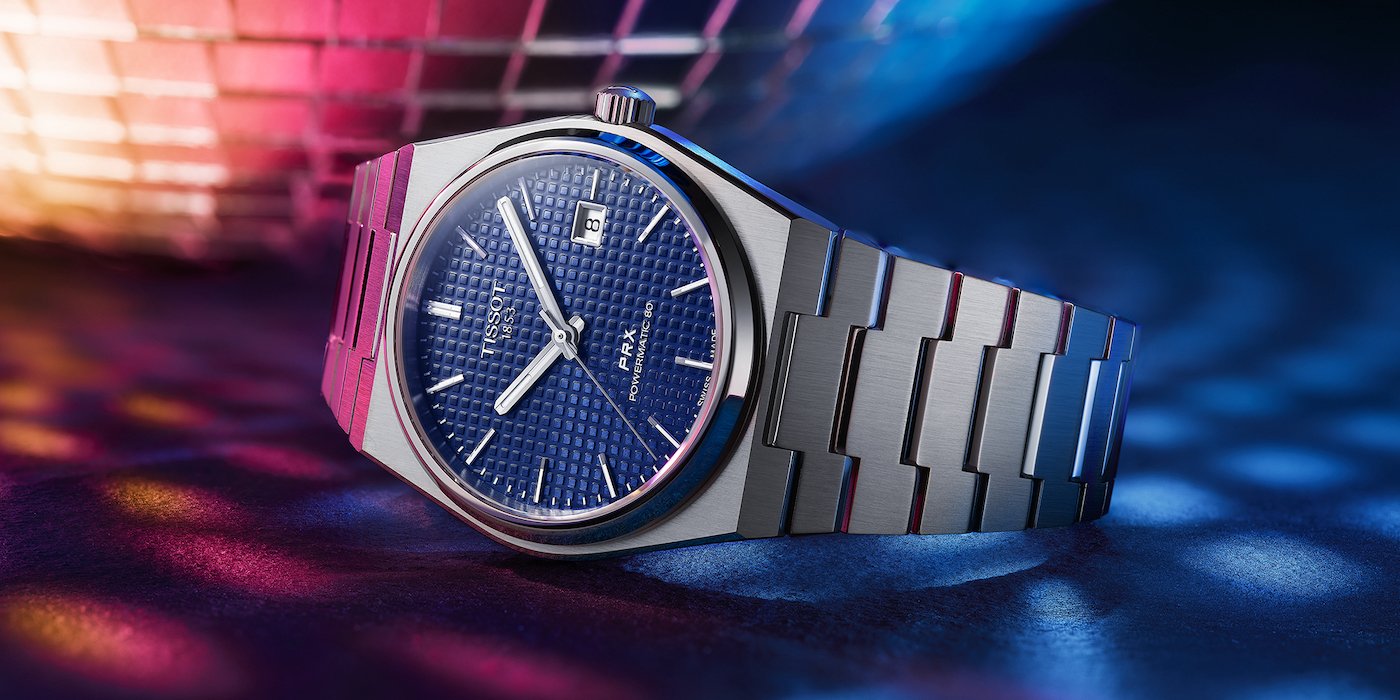n paper, Tissot would appear to be the “losing” brand, given the recent history of the Swiss watchmaking industry: record prices at auction for rare models, a premium on independent manufacturers and mechanical watches, the advent of the smartwatch...
The success of the PRX, a re-edition of a 1978 model with an integrated bracelet, challenges this preconception. This model ticks all the right generational boxes, with the right product (neo-vintage) at the right price (345 CHF for the quartz version), in an aspirational segment virtually deserted by Swiss watchmaking. Tissot is reaping the benefits: “Around 80% of customers for this model are between 20 and 25 years old,” points out CEO Sylvain Dolla.
-

- Sylvain Dolla, CEO of Tissot
While the traditional Le Locle line remains the brand’s best-seller, Tissot is capitalising on its advantage on several fronts: the now unavoidable vintage sports model with the PRX, now also available in an automatic version; the integration of the Powermatic movement with 80 hours of power reserve, (Sylvain Dolla is promising some major industrial developments on the movement front); and finally, the exploitation of the potential of solar energy – perhaps even more than its connected capabilities – with the T-Touch Connect Solar, whose dial is an actual photovoltaic cell.
We met with Sylvain Dolla to discuss this 360° innovation, which is vital for maintaining a certain level of volume – and therefore employment – in the Swiss industrial fabric.
Europa Star: Swiss watchmaking is increasingly converging around mechanical movements. What is Tissot’s strategy?
Sylvain Dolla: Our production ratio has been fairly stable over the last few years, at 55% quartz movements and 45% mechanical movements. But this year, we have seen a drastic increase in quartz watches, thanks to the success of the PRX - we will probably end the year with 65% quartz production! So it’s pretty much the opposite at Tissot.
-

- The Tissot PRX, available in quartz and automatic versions, is a re-edition of a 1978 design with integrated case and bracelet.
That’s quite surprising!
But it does not surprise me at all. Because, before you think about the movement, you have to think about the price. We must not forget the purchasing power of customers, particularly the younger ones. Obviously, automatic watches are very popular today. But there is a real demand for a beautiful Swiss watch that doesn’t cost more than CHF 400. Our quartz PRX, offered at CHF 345, is the best illustration of this. For us, design comes before movement.
-

- Tissot on the cover of Europa Star in 1981, an era of domination of quartz
This year, you’re also launching the PRX in an automatic version at CHF 645.
Yes, we are launching many of our models in both quartz and mechanical versions. We’re not putting them in competition with each other; we’re thinking about the end customer, and their ability to spend money on a Swiss watch. There’s something for everyone. Quartz vs. mechanical is a false debate. We are a volume brand, one of the last remaining in this segment of the Swiss industry. It is strategic. And we have gained a lot of market share this year.
“We’re thinking about the end customer, and their ability to spend money on a Swiss watch. There’s something for everyone. Quartz vs. mechanical is a false debate.”

At the expense of whom?
In the CHF 300-400 price segment, there is hardly anyone in Switzerland today doing volume. Our competition is more Japanese than Swiss. In terms of models, we have competitors, but they are positioned at two to three times higher prices, for a product with a similar movement.
Long-term, does the drop in export volumes pose a risk to the health of the Swiss industrial fabric?
We must not neglect the entry-level segment, because that’s where a large proportion of our potential end customers are located. A young person who appreciates Swiss watchmaking does not necessarily have CHF 1,000 to spend. Through our offer, we bring customers to Swiss watchmaking, and these are customers who will perhaps later move on to higher price segments. As far as we’re concerned, we’re going to continue to invest at this price level. We certainly won’t leave it. Our offer starts at CHF 250, thanks to quartz.
“A young person who appreciates Swiss watchmaking does not necessarily have CHF 1,000 to spend. Through our offer, we bring customers to Swiss watchmaking, and these are customers who will perhaps later move on to higher price segments.”
They are also affordable for foreign visitors. Have you suffered a lot from the lack of shopping tourism?
We do miss this segment, of course. But fortunately we’re seeing fantastic growth among local customers in Europe and the US. That’s the good thing about the last two years: our sales teams have completely refocused on local customers. Since last summer, we’ve seen record numbers in France and the UK, even compared to 2019 levels. So it is possible to record double-digit growth without the help of shopping tourism. This means there’s huge potential for our brand, with strong designs and affordable models for domestic customers.
The Powermatic 80 calibre with Nivachron escapement seems to be the new mechanical standard at Tissot. Will you be rolling it out to all your automatic collections?
Yes, for the 3-hand models. For other models, we will develop other calibres. I can’t reveal everything yet, but we are investing heavily in our industrial tooling and movements. Our collaboration with ETA is very dynamic and full of technical challenges.
“The good thing about the last two years is that our sales teams have completely refocused on local customers. It is possible to record double-digit growth without the help of shopping tourism. ”

For the T-Touch Connect Solar, you have launched an in-house operating system, and you’re collaborating with the CSEM for the solar cells. Are there any other developments in the pipeline?
I would go even further: new business lines are emerging within our brand thanks to the introduction of this new product category. A whole wing of our building in Le Locle is now occupied by developers. We’re attracting new skills. Today, we have a team of 80 people entirely dedicated to this product line and its software ecosystem. We’re working on new features. The watch still tells the time, even when it’s not connected. It doesn’t need to be recharged, it is truly autonomous. We are also continuing to invest in solar cell manufacture.
-

- The T-Touch Connect Solar has the functionality of a T-Touch Solar Expert, as well as an activity tracker, app notifications and updates.
Will you continue to produce them at the CSEM, or will you bring them back to your premises?
We’re in the process of building a clean room so that we can bring this expertise in-house. Here too, new professions are emerging. I want to develop solar energy as much as possible at Tissot. We’re creating jobs and maintaining the industrial fabric in Switzerland, rather than importing unsightly solar cells from Asia. The big advantage of this Swiss R&D is that it has led to the solar cell becoming the actual watch face. Why is that? Because the product was designed by watchmakers, right from the start of the research. And every line of code in the operating system has been designed to be energy efficient. This is only possible with an in-house system. In con- sumer electronics, this is not even a consideration, since you have to recharge your watch or phone every 24 hours. We have developed a whole ecosystem around the concept of low consumption.
“A whole wing of our building in Le Locle is now occupied by developers. We’re attracting new skills.”
Is there a specific distribution channel for this model, for example in electronics or sports shops, outside the traditional watchmaking channels?
No, we remain watchmakers, we don’t make smartwatches or commodities. These are long-lasting products. They’re available from our own boutiques and specialised retailers that we have carefully selected. Today we have a network of about 12,000 points of sale worldwide and “only” 2,800 of them sell the T-Touch Connect Solar. We have to train our staff thoroughly for this particular product, and we do this through selective distribution. On the other hand, online sales are important for this segment.
Have you closed many sales outlets during the pandemic crisis?
We closed where it made sense, especially in Hong Kong. We now have 260 of our own stores or franchisees, and we’re starting to expand the network again, for example recently in Rome and Tokyo.
Are you going to “connect” other lines in the next few years?
We will introduce new connected T-Touch models next year, and we have plans to extend connection to other watches. But they won’t be smartwatches: just beautiful “augmented” watches!
























































